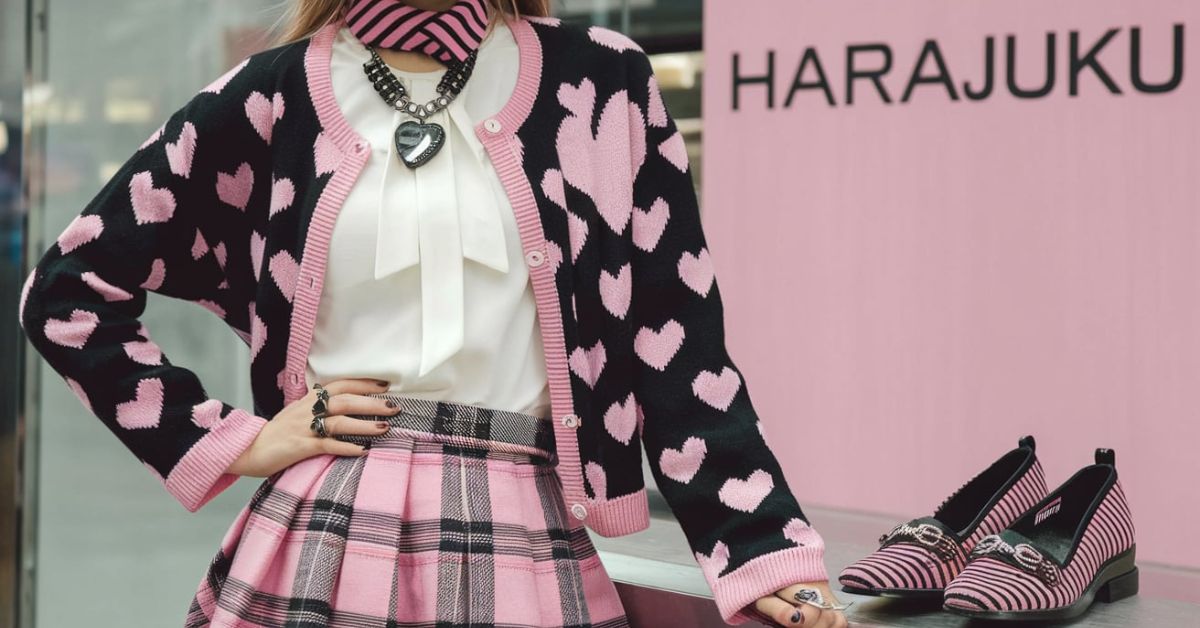Welcome to the kaleidoscopic world of Harajuku fashion, where creativity knows no bounds and self-expression reigns supreme. This blog post will take you on a captivating journey through the heart of Tokyo’s most eclectic fashion district, exploring the origins, evolution, and global impact of this unique style phenomenon.
The Birth of Harajuku Fashion: A Colorful Revolution
Harajuku fashion didn’t just appear overnight. It’s a tale of post-war resilience, youth rebellion, and cultural fusion that’s as colorful as the outfits it spawned.
Post-World War II Influences
After World War II, Japan experienced a cultural renaissance. The Harajuku district, nestled in the heart of Tokyo, became a melting pot of Western influences and traditional Japanese aesthetics. This fusion laid the groundwork for what would become .
Harajuku fashion is not just about clothes; it’s a form of art, a way of life.- Kyary Pamyu Pamyu, Harajuku fashion icon
The Rise of Youth Culture
In the 1970s and 1980s, Harajuku became the epicenter of Japan’s youth culture. Teens and young adults flocked to the area, transforming it into a playground for fashion experimentation. This era saw the birth of many alternative styles that would later define Hara fashion.
Global Recognition: FRUiTS Magazine and Beyond
The 1990s marked a turning point for Harajuku fashion. The launch of FRUiTS magazine in 1997 catapulted Japanese street style onto the global stage. Suddenly, the world couldn’t get enough of the bold, eccentric outfits gracing the streets of Tokyo.
Key Harajuku Fashion Subcultures: A Diverse Tapestry

Harajuku fashion isn’t a single style; it’s a vibrant tapestry of subcultures, each with its own unique aesthetic. Let’s dive into some of the most iconic:
Decora: The Art of More is More
Decora is all about excess. Think layers upon layers of bright colors, countless accessories, and an unapologetic embrace of all things kawaii (cute).
Key elements of Decora style:
- Rainbow color palettes
- Layered clothing (skirts over pants, multiple tops)
- Abundant accessories (hair clips, bracelets, pins)
- Cute character motifs (Hello Kitty, Pokémon)
Lolita: Victorian-Inspired Elegance
Lolita fashion takes inspiration from Victorian and Rococo-era clothing, creating a doll-like aesthetic that’s both elegant and whimsical.
Types of Lolita fashion:
| Style | Description | Key Elements |
|---|---|---|
| Sweet Lolita | Pastel colors, childlike motifs | Ruffles, bows, cupcake prints |
| Gothic Lolita | Dark colors, Victorian influence | Crosses, lace, dark makeup |
| Classic Lolita | Mature, refined look | Muted colors, subtle patterns |
Visual Kei: Rock-Inspired Androgyny
Born from Japan’s rock music scene, Visual Kei blurs gender lines with its dramatic, androgynous aesthetic.
Characteristics of Visual Kei:
- Elaborate hairstyles (often spiked or teased)
- Heavy makeup for all genders
- Leather, studs, and chains
- Influences from glam rock and punk
Ganguro and Gyaru: Rebellious Glamour
These styles emerged as a rebellion against traditional Japanese beauty standards, embracing tanned skin, bleached hair, and bold makeup.
Iconic Harajuku Fashion Elements: Building Blocks of Style
While Harajuku fashion is known for its diversity, certain elements appear across multiple subcultures:
- Bold color combinations: Clashing colors are celebrated, not avoided.
- Layering techniques: Multiple pieces are worn together in unexpected ways.
- Mix-and-match aesthetics: Different styles and eras are blended seamlessly.
- Kawaii culture influence: Cute motifs and childlike elements are prevalent.
- DIY and customization: Many Harajuku fashionistas create or modify their own clothing.
Harajuku Fashion Icons and Influencers: Shaping the Scene
Several key figures have played a crucial role in shaping and promoting Harajuku fashion:
- Kyary Pamyu Pamyu: Pop star and Harajuku fashion ambassador
- Sebastian Masuda: Artist and founder of 6%DOKIDOKI, a famous Harajuku boutique
- YOHJI YAMAMOTO: Avant-garde designer who helped put Harajuku on the global fashion map
The Evolution of Harajuku Fashion: From Streets to Screens
Harajuku has come a long way since its early days. Let’s explore how it’s changed and adapted over time.
Impact of Social Media and Globalization
The rise of platforms like Instagram and TikTok has given a global stage. Influencers from around the world now showcase their Harajuku-inspired looks to millions of followers.
Mainstream Adoption and Commercialization
As fashion gained popularity, it caught the eye of mainstream fashion brands. Today, you can find-inspired pieces in stores worldwide, from fast fashion retailers to high-end designers.
Preservation Efforts and Concerns
With the commercialization of Harajuku, some worry about losing its authentic, DIY spirit. However, many in the community are working to preserve the original creativity and individuality that made fashion so special.
Harajuku Fashion Beyond Japan: A Global Phenomenon
Harajuku fashion has left an indelible mark on global street style and high fashion alike.
Global Impact on Street Style
From New York to Paris, elements of Harajuku fashion can be seen in street style around the world. The bold colors, eclectic mixing of styles, and emphasis on self-expression have inspired fashion lovers globally.
Influence on High Fashion and Designers
Many high-fashion designers have drawn inspiration from . Brands like Comme des Garçons and Junya Watanabe have brought elements of Tokyo street style to the runways of Paris and Milan.
Harajuku-Inspired Events and Communities Worldwide
Harajuku fashion has spawned a global community. Events like Walk in Los Angeles and Harajuku-inspired meetups in cities worldwide celebrate this unique style.
How to Incorporate Harajuku Style in Your Wardrobe: Tips and Tricks
Want to add a touch of Harajuku flair to your wardrobe? Here are some tips:
- Start small: Begin with accessories like colorful socks or hair clips.
- Embrace mixing patterns: Don’t be afraid to pair florals with stripes or polka dots.
- Layer creatively: Try wearing a dress over pants or layering multiple tops.
- DIY: Customize your clothes with patches, pins, or your own artwork.
- Shop secondhand: Thrift stores are great for finding unique pieces to mix and match.
The Future of Harajuku Fashion: What’s Next?
As we look to the future, Harajuku fashion continues to evolve and surprise us.
Emerging Trends and New Subcultures
New subcultures are always emerging in Harajuku. Keep an eye out for styles like Yami Kawaii (dark cute) and Menhera (mental health awareness fashion).
Sustainability and Ethical Concerns
As global awareness of environmental issues grows, many in the fashion community are embracing sustainable and ethical fashion practices.
The Role of Technology in Shaping Future Styles
From AR filters that let you try on Harajuku looks to AI-designed clothing, technology is set to play a big role in the future of.
FAQs: Your Harajuku Fashion Questions Answered
Q: What’s the difference between Harajuku and Kawaii fashion?
A: While there’s overlap, Harajuku encompasses a broader range of styles, including but not limited to Kawaii. Kawaii specifically refers to “cute” fashion, which is one aspect of Harajuku style.
Q: Is Harajuku fashion expensive?
A: It can be, but it doesn’t have to be. Many Harajuku fashionistas create their looks through thrifting, DIY, and mixing high and low-end pieces.
Q: Can anyone wear Harajuku-inspired outfits?
A: Absolutely! Harajuku is all about self-expression and creativity. Anyone can incorporate elements of Harajuku style into their wardrobe.
Q: How has COVID-19 affected Harajuku fashion?
A: The pandemic has led to more online communities and virtual fashion shows. It’s also inspired creative mask designs and a focus on comfortable yet stylish at-home wear.
Q: Are there any taboos or cultural sensitivities to be aware of?
A: While Harajuku fashion is generally open and accepting, it’s important to be respectful of its Japanese origins and avoid cultural appropriation.
Conclusion: The Enduring Legacy of Harajuku Fashion
Harajuku fashion is more than just clothes; it’s a vibrant celebration of individuality, creativity, and cultural fusion. From its roots in post-war Japan to its current status as a global phenomenon, fashion continues to inspire and delight fashion lovers worldwide.
Whether you’re a longtime fan of Japanese street style or just discovering the colorful world of Harajuku fashion, there’s always something new to explore and admire in this ever-evolving scene. So why not add a touch of Harajuku flair to your wardrobe? After all, in the world of , the only rule is to be unapologetically yourself.

Fashion is a Professional Fashion Platform. Here we will provide you only interesting content, which you will like very much. We’re dedicated to providing you the best of Fashion, with a focus on dependability and Fashion. We’re working to turn our passion for Fashion into a booming online website. We hope you enjoy our Fashion as much as we enjoy offering them to you.
